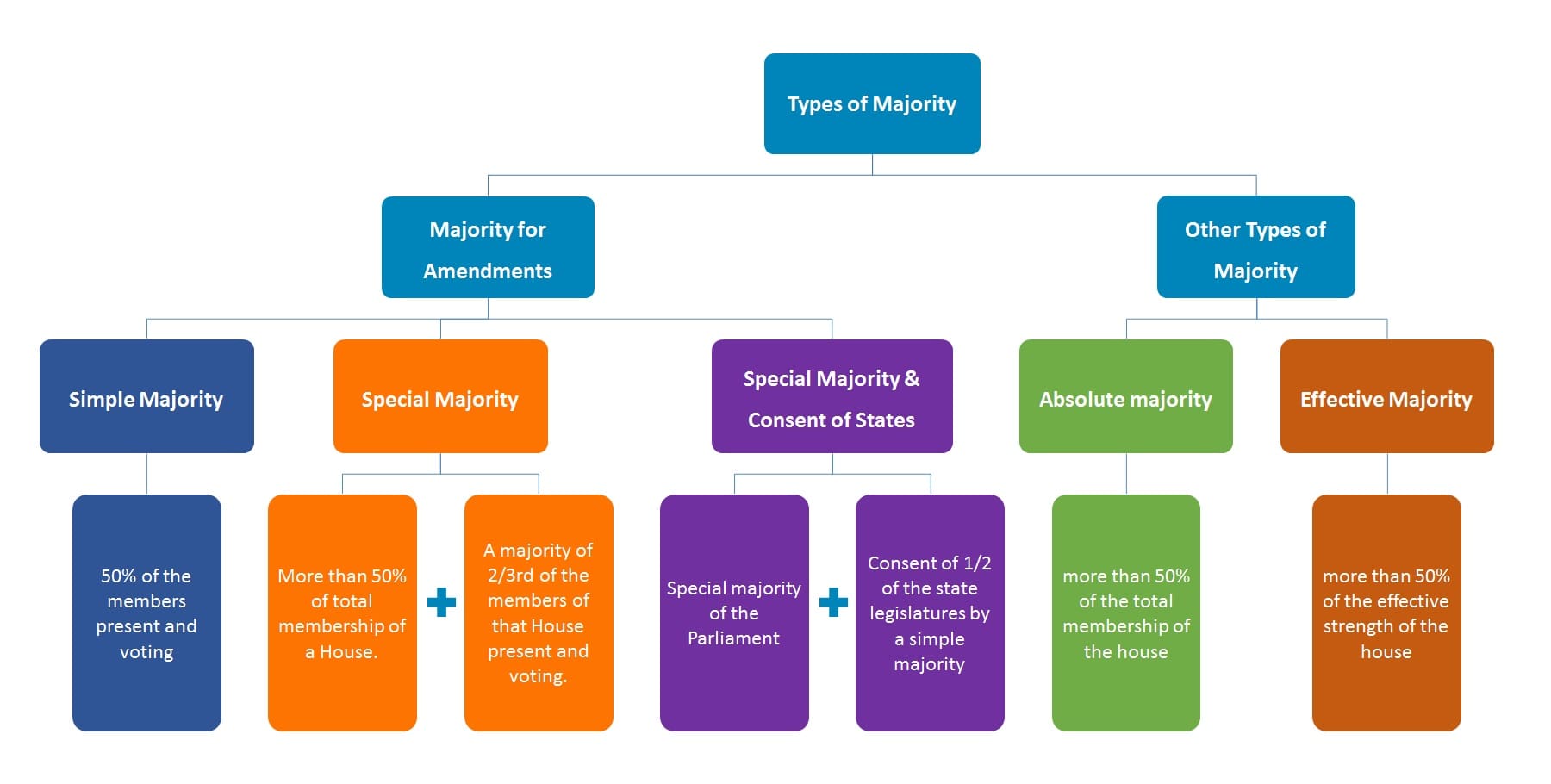Contents
types of Majority in Parliament
- Article 368 in Part XX
- This article deals with the powers of Parliament to amend the Constitution and its procedure.
- Parliament may, amend by way of addition, variation or repeal any provision of the Constitution.
- It must be done in accordance with the procedure laid down for this purpose.
- Parliament cannot amend those provisions which form the ‘basic structure’ of the Constitution.
Procedure of Amendments of the Constitution
- An amendment to the Constitution can be initiated only by the introduction of a bill for the purpose in either House of Parliament.
- The bill can be introduced either by a minister or by a private member.
- It does not require prior permission of the president.
- The bill must be passed in each House by a special majority.
- Each House must pass the bill separately.
- In case of a disagreement between the two Houses, there is no provision for holding a joint sitting of the two Houses.
- If the bill seeks to amend the federal provisions of the Constitution, it must be passed by the Special Majority of Parliament & Consent of States.
- After duly passed by both Houses of Parliament and ratified by the state legislatures, where necessary, the bill is presented to the president for assent.
- The president must give his assent to the bill.
- He can neither withhold his assent to the bill nor return the bill for reconsideration of the Parliament.
- After the president’s assent, the bill becomes an Act (constitutional amendment act).
types of Majority in Parliament

Types of Majority for Amendments
- Article 368 provides for two types of amendments
- Some other articles provide for the amendment of certain provisions of the Constitution by a simple majority of Parliament
- Constitution can be amended in 3 ways:
- Simple majority of the Parliament
- Special majority of the Parliament
- Special majority of the Parliament and the ratification of half of the state legislatures
Simple Majority of Parliament
- Simple majority refers to more than 50% of the members present and voting.
- It is also called as or working majority.
- A number of provisions in the Constitution can be amended by a simple majority of the two Houses of Parliament outside the scope of Article 368.
- Admission or establishment of new states.
- Formation of new states and alteration of areas, boundaries, or names of existing states.
- Abolition or creation of legislative councils in states.
- 2nd Schedule – emoluments, allowances, privileges, and so on of the president, the governors, the Speakers, judges, etc.
- Quorum in Parliament.
- Salaries and allowances of the members of Parliament.
- Rules of procedure in Parliament.
- Privileges of the Parliament, its members, and its committees.
- Use of English language in Parliament.
- Number of puisne judges in the Supreme Court.
- Conferment of more jurisdiction on the Supreme Court.
- Use of official language.
- Citizenship – acquisition and termination.
- Elections to Parliament and state legislatures.
- Delimitation of constituencies.
- Union territories.
- 5th Schedule – administration of scheduled areas and scheduled tribes.
- 6th Schedule – administration of tribal areas.
types of Majority in Parliament
Special Majority of Parliament
- Special majority needed both of the following
- More than 50% of the total membership of a House.
- A majority of 2/3rd of the members of that House present and voting.
- Most of the provisions in the Constitution need to be amended by a special majority of the Parliament.
- Fundamental Rights
- Directive Principles of State Policy
- All other provisions which are not covered by the first and third categories
Special Majority of Parliament & Consent of States
- This type of amendment is related to the federal structure of the Indian constitution.
- Those provisions can be amended by both of following
- Special majority of the Parliament
- Consent of half of the state legislatures by a simple majority
- If one or some or all the remaining states take no action on the bill, it does not matter.
- The moment half of the states give their consent, the formality is completed.
- There is no time limit within which the states should give their consent to the bill.
- Federal structure provisions are
- Election of the President and its manner.
- Extent of the executive power of the Union and the states.
- Supreme Court and high courts.
- Distribution of legislative powers between the Union and the states.
- Any of the lists in the 7th Schedule.
- Representation of states in Parliament.
- Power of Parliament to amend the Constitution and its procedure (Article 368 itself).
Other Types of Majority
Absolute majority
- Absolute majority refers to more than 50% of the total membership of the house.
- Total membership of Lok Sabha is 545.
- Absolute majority in Lok Sabha means – 50% of 545 + 1 = 273
- Absolute majority is related to the formation of a government or to keep the confidence of the house at the Center and States.
Effective Majority
- It means more than 50% of the effective strength of the house.
- So, out of the total strength, we deduct the vacant seats.
- Indian Constitution mentions “all the then members”, which means the effective majority.
- The effective majority is used to remove
- Vice-president in Rajya Sabha.
- Speaker and Deputy speaker of Lok Sabha and State Legislative Assembly.
Notes
- 24th Constitutional Amendment Act of 1971 made it obligatory for the President to give his assent to a Constitutional Amendment Bill.




